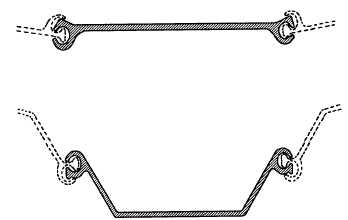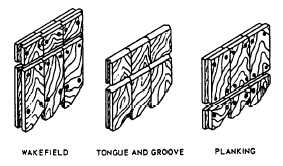Figure 1-10.—Types of concrete piles.
Bearing Piles
Timber bearing piles are usually straight tree trunks
with the limbs and bark removed. These piles, if kept
continuously wet, will last for centuries; however, they
are used for low design loads because of their
vulnerability to damage while they are being driven into
the ground. The small end of the pile is called the tip;
the larger end is called the butt. Timber piles range from
16 to 90 feet in length with a tip diameter of at least 6
inches. The butt diameter is seldom less than 12 inches.
A steel bearing pile might be an H-pile (having an
H-shaped cross section). These piles are usually used for
driving to bedrock. A steel pile can also be a pipe pile
with a circular cross section. A pipe pile can be either an
open-end pile or a closed-end pile, depending on
whether the bottom end is open or closed.
Concrete piles, such as those shown in figure 1-10,
may be either precast or cast in place. Most precast piles
used today are pretensioned and are manufactured in
established plants. These piles are made in square,
cylindrical, or octagonal shapes. If they are being driven
into soft or mucky soil, they are usually tapered.
Cast-in-place piles are cast on the jobsite and are
classified as shell type or shell-less type. The shell type
is formed by driving a hollow steel tube (shell), with a
closed end, into the ground and filling it with concrete.
The shell-less type is formed by first driving a casing
and core to the required depth. The core is removed and
Figure 1-11.—Steel sheetpiling.
Figure 1-12.—Wood sheet piles.
is then
the casing is filled with concrete. The casing
removed, leaving the concrete in contact with the earth.
Sheet Piles
Sheet piles, made of wood, steel, or concrete, are
equipped or constructed for edge-joining, so they can be
driven edge-to-edge to form a continuous wall or
bulkhead. A few common uses of sheet piles are as
follows:
1. To resist lateral soil pressure as part of a
temporary or permanent structure, such as a retaining
wall
2. To construct cofferdams or structures built to
exclude water from a construction area
3. To prevent slides and cave-ins in trenches or
other excavations
The edges of steel sheetpiling are called interlocks
(fig. 1-11) because they are shaped for locking the piles
together edge-to-edge. The part of the pile between the
interlocks is called the web.
A wood sheet pile might consist of a single, double,
or triple layer of planks, as shown in figure 1-12.
Concrete sheet piles are cast with tongue-and-groove
edges for edge-joining.
1-7











